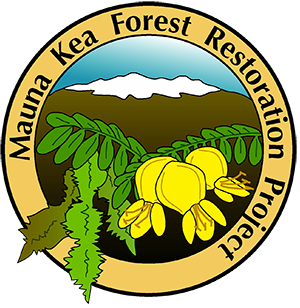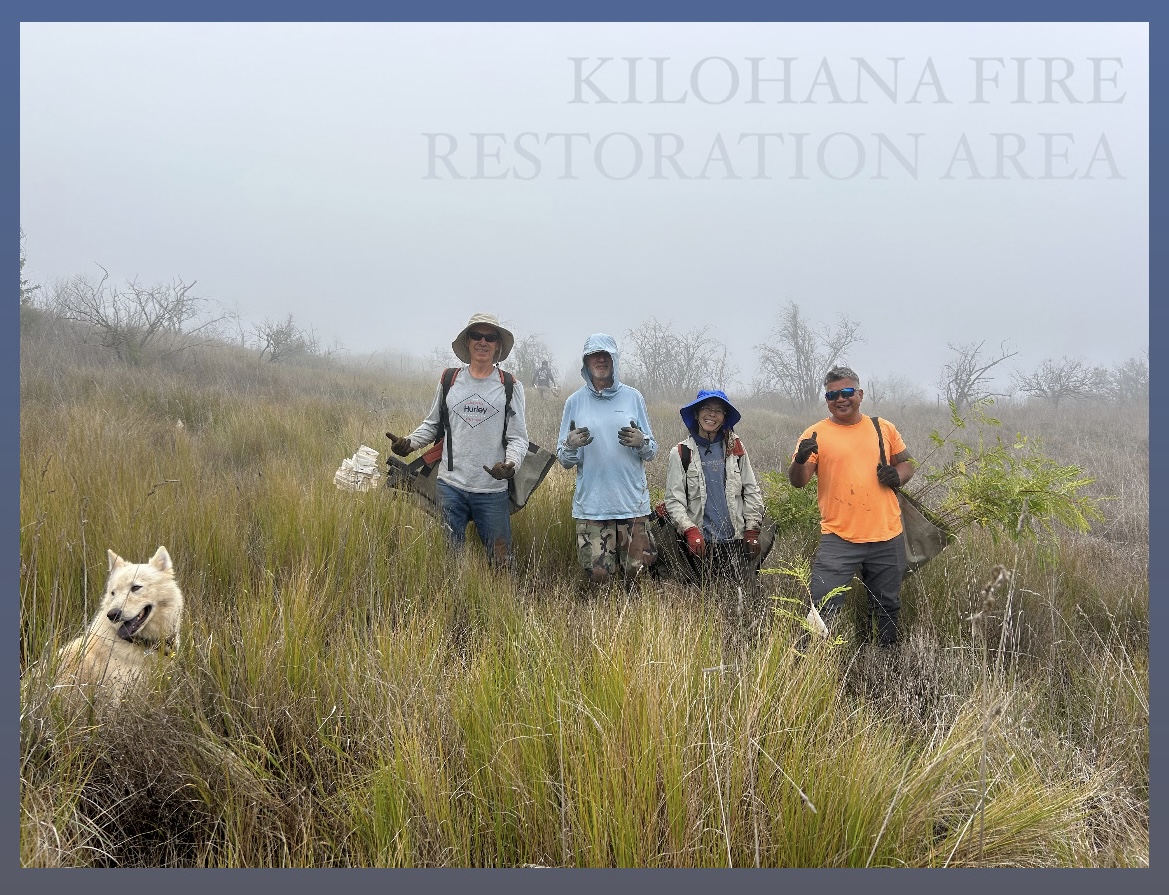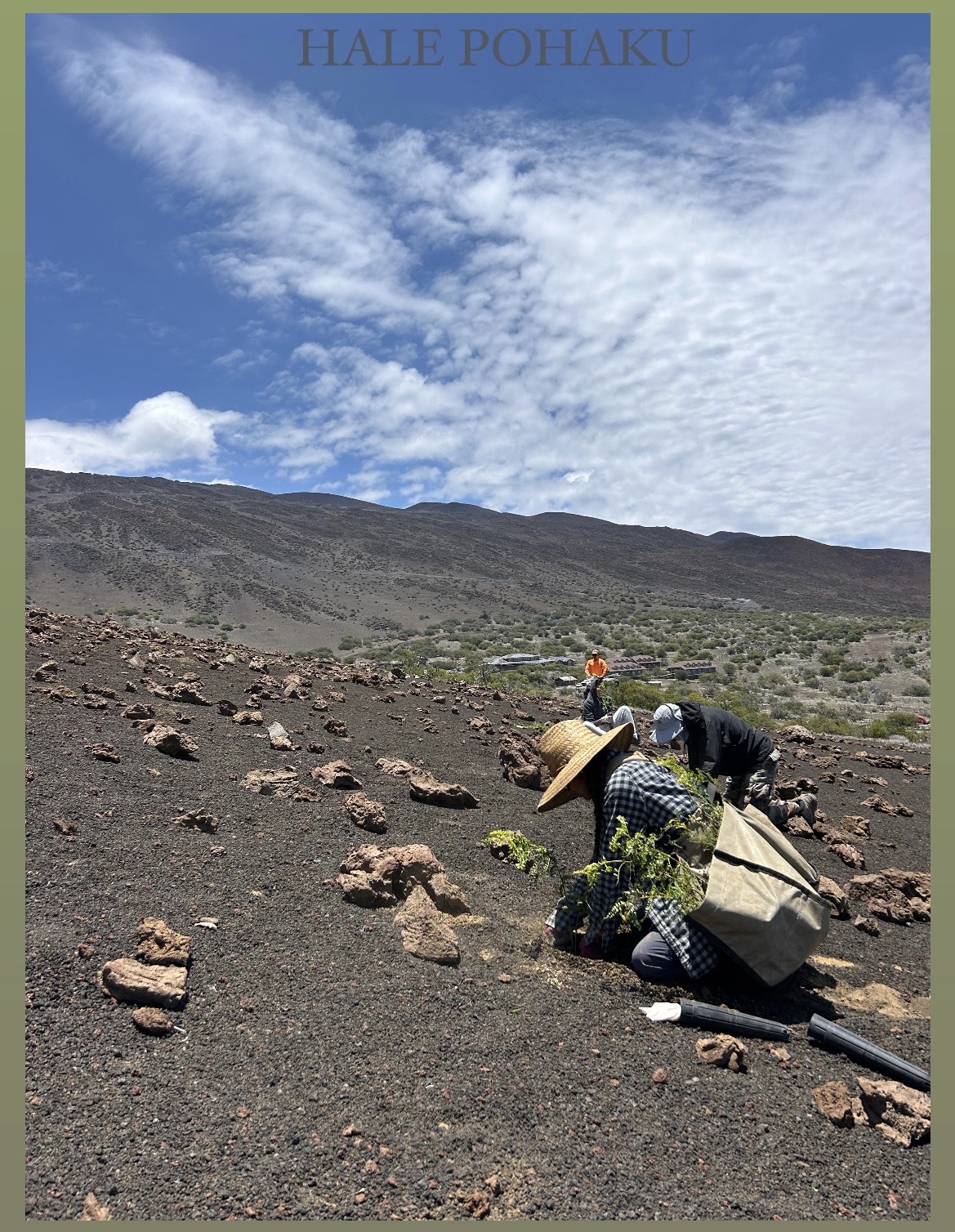Restoration Areas
Restoration Areas
Kilohana Fire Restoration Area (R1)
Location: Western slope of Mauna Kea near the Kilohana Hunter Check In Station and downslope of Mauna Kea Forest Reserve.
Driving time: 1 hour from Hilo; 1 hour from Waimea.
Elevation range: 5,000 ft. – 6,000 ft.
Fence: 6-ft. woven-wire ungulate exclosure fence completed in 2006.
Current forest: The upper and lower portions of the area support māmane and naio, however much of this area is pasture. The understory is dominated by non-native species including kikuyu grass (Pennisetum clandestinum) and fireweed (Senecio madagascariensis). ‘Ūlei (Osteomeles anthyllidifolia) , ‘a‘ali‘i (Dodonea viscosa) , and Pili Grass (Heterogpogon contortus) occur in some areas.
Current management efforts: Current management efforts are to provide a canopy for native birds to once again inhabit the area. There has also been many threats to palila critical habitat due to fires within the area. Providing this area with trees will hopefully prevent fires from accelerating up the mauna. We also would like to provide a future seed bank for native trees for future generations.
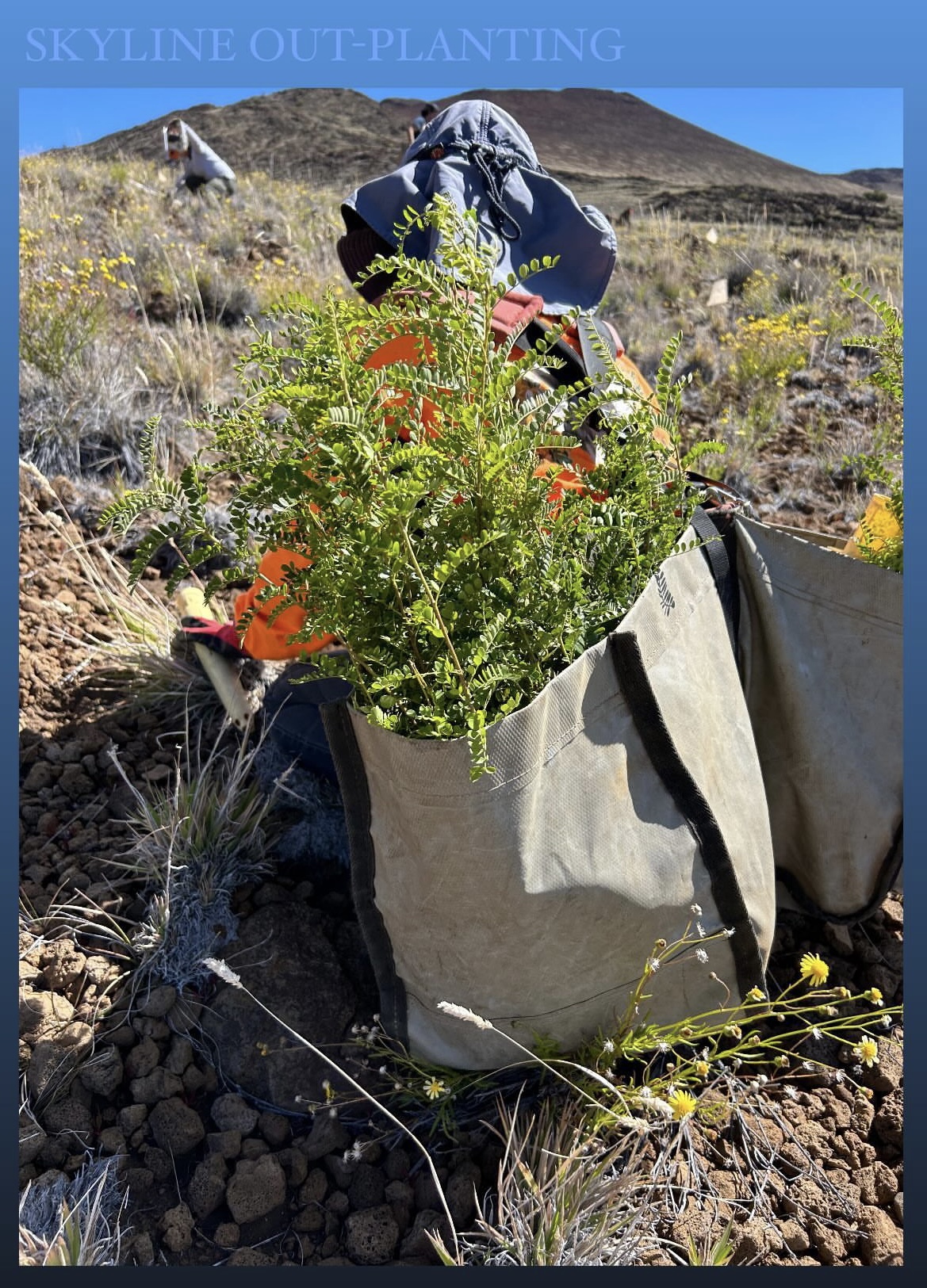
Skyline
Location: Upslopes of Mauna Kea Forest Reserve.
Driving time: 1 1/2 hour from Hilo; 2 hour from Waimea.
Elevation range: 9,000 ft. – 11,000 ft.
Fence: 6-ft. woven-wire ungulate exclosure fence completed in 2006.
Current forest: These high slopes of the mauna provide soil mixed in with cinder and ‘a‘ā lava rocks. The area is mainly populated with pūkiawe (Leptecophylla tameiameiae) and ‘Ōhelo (Vaccinium spp.).
Current management efforts: Outplanting efforts from multiple groups have had the goal to create future forests for palila and other native species. Plant species included in this are māmane (Sophora chrysophylla) , ‘a‘ali‘i (Dodonea viscosa) , ‘iliahi (Santalum paniculatum) , and ‘Ahinahina (Argyroxiphium sandwicense ssp. sandwicense) .
Hale Pohaku
Location: Eastern slopes of MaunaKea near the Astronomy Visitor Center.
Driving time: 1 1/2 hour from Hilo; 2 1/2 hours from Waimea.
Elevation range: 8,000 ft. – 11,000 ft.
Fence: 6-ft. woven-wire ungulate exclosure fence completed in 2006.
Current forest: These high slopes of the mauna provide soil mixed in with cinder, black sand, and ‘a‘ā lava rocks. The area is mainly populated with pūkiawe (Leptecophylla tameiameiae) and ‘Ōhelo (Vaccinium spp.)
Current management efforts: Outplanting efforts from multiple groups have had the goal to create future forests for palila and other native species. Plant species included in this are māmane (Sophora chrysophylla) , ‘a‘ali‘i (Dodonea viscosa) , and ‘Ahinahina (Argyroxiphium sandwicense ssp. sandwicense) .
Pu‘u Mali Restoration Area
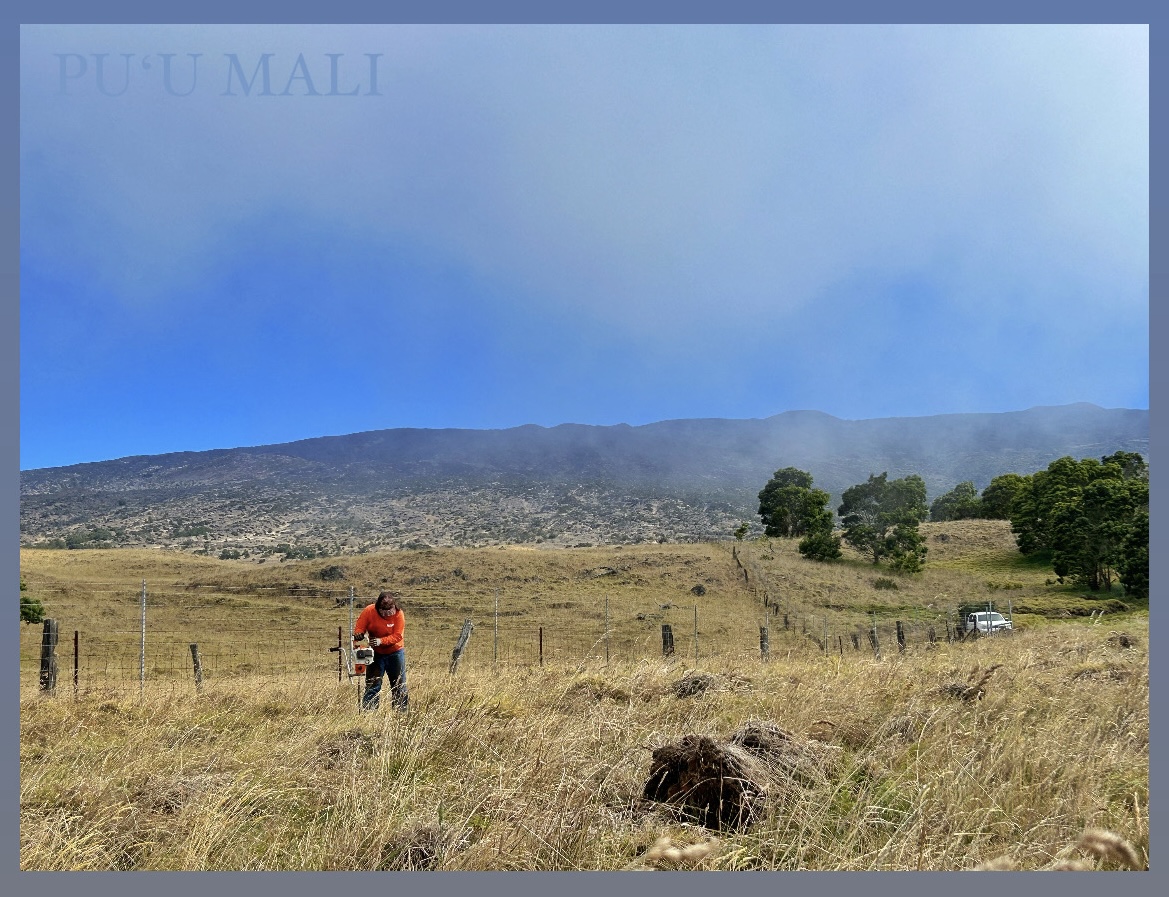
Location: Northern slope of Mauna Kea. The area is adjacent to Mauna Kea Forest Reserve.
Driving time: 2 1/2 hours from Hilo; 1 hour from Waimea.
Size: 5,140 acres
Elevation range: 5,200 ft. – 7,800 ft.
Fence: 6-ft. woven-wire ungulate exclosure fence completed in 2006.
History: Prior to cattle ranching, this site supported koa (Acacia koa) in the lower sections, with māmane (Sophora chrysophylla), naio (Myoporum sandwicense), and ‘akoko (Chamaesyce olowaluana) in the upper areas. Native Hawaiians rarely visited these high elevation forests or the wao ākua (realm of the gods), although they may have passed though the forest on their way to adze quarries at higher elevations. With the arrival of Europeans, this area was degraded by centuries of cattle grazing. Livestock were completely removed in 2010..
Current forest: A 4,000–14,000 year old ‘a‘ā lava flow covers the eastern portion of Pu‘u Mali Restoration Area while the western part was entirely converted to pastureland. Māmane and koa snags still stand in the pasture areas providing a reminder of the forest that we are restoring. Some native plants remain in the pasture in the gulches and rocky outcroppings which were inaccessible to ungulates. The ‘a‘ā flow protected native vegetation from cattle and supports a māmane-dominated forest with a substantial population of ‘akoko. The ‘a‘ā flow also supports rich native plant diversity including na‘ena‘e (Dubautia arborea), ko‘oko‘olau (Bidens menziesii), small-leafed mā‘ohi‘ohi (Stenogyne microphylla), ‘āweoweo (Chenopodium oahuense), ‘ānunu (Sicyos macrophyllus), and Hawaiian stinging nettle (Hesperocnide sandwicensis)
Current management efforts: A field camp serves as a base for staff, researchers, and volunteers. Current activities include: (1) site preparation prior to out-planting, (2) collecting native seeds, (3) out-planting seedlings, (4) scattering native seeds, (5) controlling cape ivy (Delairea odorata) and fountain grass (Pennisetum setaceum), and (7) monitoring/maintaining the perimeter fence at Pu‘u Mali Restoration Areas and the new Palila Critical Habitat fence.
Ka‘ohe Restoration Area
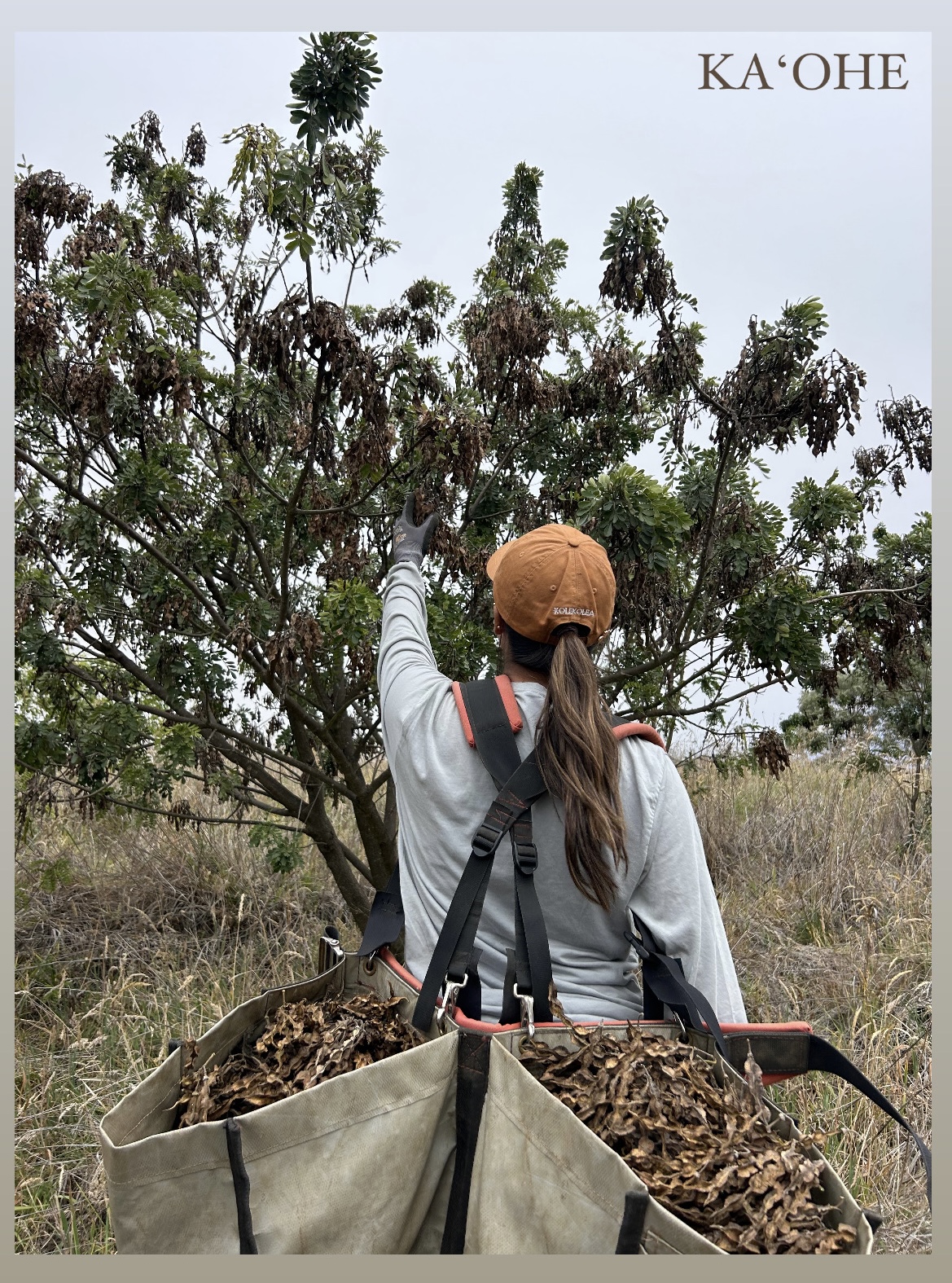
Location: Western slope of Mauna Kea adjacent to Ka‘ohe Game Management Area, Parker Ranch, and downslope of Mauna Kea Forest Reserve.
Driving time: 1 1/2 hours from Hilo; 1/2 hour from Waimea.
Size: 1,400 acres
Elevation range: 5,800 ft. – 7,000 ft.
Fence: 4-ft. woven-wire ungulate exclosure fence completed in 2006.
History: Historically, this site supported a rich dry forest of māmane (Sophora chrysophylla) and naio (Myoporum sandwicense). Native Hawaiians rarely visited high elevation forests or the wao ākua (realm of the gods), although they may have passed though the forest on their way to adze quarries at higher elevations. With the arrival of Europeans, this area was degraded by centuries of cattle grazing. Aerial photos from 1950 indicate that a dense
forest existed on site. However, much of the forest was converted to pasture and today the remaining forest is highly degraded. Livestock were completely removed in 2010. It is classified as Palila (Loxioides bailleui) Critical Habitat.
Current forest: The upper and lower portions of the area support māmane and naio; much of the area in between the upper and lower portions is pasture. Cape ivy (Delairea odorata) is an invasive vine present throughout most of the forested area. The understory is dominated by non-native species including kikuyu grass (Pennisetum clandestinum) and fireweed (Senecio madagascariensis). ‘Ulei (Osteomeles anthyllidifolia) and ‘a‘ali‘i (Dodonea viscosa) occur in some areas. Māmane seedlings are sprouting throughout the unit now that ungulates have been removed.
Current management efforts: (1) site preparation prior to out-planting, (2) collecting native seeds, (3) out-planting seedlings, (4) scattering native seeds, (5) controlling cape ivy and fountain grass, and (7) monitoring/ maintaining the perimeter fence at Restoration Areas and the new Palila Critical Habitat fence.
